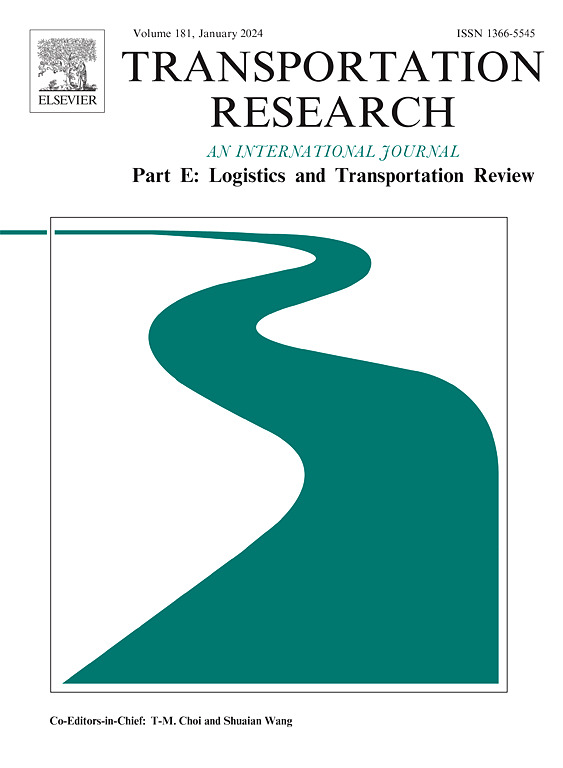Behind the scenes or front? Branding strategy of technology provider in a technology-intensive supply chain
IF 8.3
1区 工程技术
Q1 ECONOMICS
Transportation Research Part E-Logistics and Transportation Review
Pub Date : 2025-01-17
DOI:10.1016/j.tre.2025.103961
引用次数: 0
Abstract
In a technology-intensive supply chain, branding can significantly enhance consumers’ perception of a technology’s contribution to the final products, making it potentially beneficial for the technology provider. However, many technology providers operate behind the scenes as pure suppliers, rather than branding themselves. The reasons behind these heterogeneous branding decisions among technology providers remain unclear. Our findings suggest that without branding, the technology provider’s profitability is largely determined by the manufacturer’s quality. As a result, even if a technology provider offers technology of higher quality and possesses greater bargaining power, it may not necessarily realize higher profits. Branding can significantly mitigate this effect, allowing the technology provider to gain profit without being constrained by the manufacturer’s quality. The trade-off between bargaining power and additional branding costs plays a key role in the technology provider’s profitability. Interestingly, while one might expect that increasing the technology provider’s bargaining power would hurt the manufacturer’s profit, our findings show that when the technology provider opts for branding, an increase in bargaining power can lead to a win-win solution, provided that the branding cost is not too high. We further extend the model to investigate how the technology provider’s encroachment decision affect the competitive decision within the branding strategy. Finally, we examine the robustness of the major results by employing different decision sequences and licensing fee structures. Overall, the results of this paper offer technology providers valuable insights into the advantages and disadvantages of the branding strategy.
幕后还是前台?技术密集型供应链中技术供应商的品牌战略
在技术密集型供应链中,品牌化可以显著增强消费者对技术对最终产品的贡献的认知,使其对技术提供者有潜在的好处。然而,许多技术提供商在幕后以纯粹的供应商的身份运作,而不是给自己打上品牌。技术供应商做出这些异质品牌决策背后的原因尚不清楚。我们的研究结果表明,在没有品牌的情况下,技术提供商的盈利能力在很大程度上取决于制造商的质量。因此,即使技术提供者提供更高质量的技术,拥有更大的议价能力,也不一定能获得更高的利润。品牌可以显著减轻这种影响,使技术提供商在不受制造商质量限制的情况下获得利润。议价能力和额外品牌成本之间的权衡在技术提供商的盈利能力中起着关键作用。有趣的是,虽然人们可能会认为增加技术供应商的议价能力会损害制造商的利润,但我们的研究结果表明,当技术供应商选择品牌时,议价能力的增加可以导致双赢的解决方案,前提是品牌成本不太高。我们进一步扩展了该模型,以研究技术提供商的入侵决策如何影响品牌战略中的竞争决策。最后,我们通过采用不同的决策序列和许可费用结构来检验主要结果的鲁棒性。总体而言,本文的结果为技术提供商提供了有价值的见解,以了解品牌战略的优势和劣势。
本文章由计算机程序翻译,如有差异,请以英文原文为准。
求助全文
约1分钟内获得全文
求助全文
来源期刊
CiteScore
16.20
自引率
16.00%
发文量
285
审稿时长
62 days
期刊介绍:
Transportation Research Part E: Logistics and Transportation Review is a reputable journal that publishes high-quality articles covering a wide range of topics in the field of logistics and transportation research. The journal welcomes submissions on various subjects, including transport economics, transport infrastructure and investment appraisal, evaluation of public policies related to transportation, empirical and analytical studies of logistics management practices and performance, logistics and operations models, and logistics and supply chain management.
Part E aims to provide informative and well-researched articles that contribute to the understanding and advancement of the field. The content of the journal is complementary to other prestigious journals in transportation research, such as Transportation Research Part A: Policy and Practice, Part B: Methodological, Part C: Emerging Technologies, Part D: Transport and Environment, and Part F: Traffic Psychology and Behaviour. Together, these journals form a comprehensive and cohesive reference for current research in transportation science.

 求助内容:
求助内容: 应助结果提醒方式:
应助结果提醒方式:


